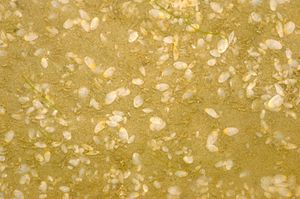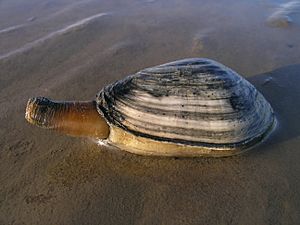Soft-shell clam facts for kids
Quick facts for kids Soft-shell clam or Sand Gaper |
|
|---|---|
 |
|
| Scientific classification | |
| Genus: |
Mya
|
| Species: |
arenaria
|
Soft-shell clams are also known as sand gapers. Their scientific name is Mya arenaria. People also call them "steamers" or "Ipswich clams." These clams are a type of edible saltwater clam. They are a kind of bivalve mollusc, which means they have two shells. They belong to the family Myidae.
Contents
Where Soft-Shell Clams Live
These clams live buried in the sand or mud. You can find them on tidal flats. These are flat areas of land that are covered by water at high tide and exposed at low tide. While they are common in muddy places, their name "arenaria" means sandy. This shows they also like sandy areas.
You can find soft-shell clams along the coast of New England in the Western Atlantic Ocean. Their home range goes far north into Canada and south to the Southern states. They also live in the Eastern Atlantic Ocean, like in the UK. They are common in the North Sea's Wadden Sea.
How Clams Spread
This clam species has become an invasive species on the Pacific Coast of North America. This includes places like Alaska and Canada. However, M. arenaria actually started in the Pacific Ocean a long time ago. It spread to the Atlantic Ocean, including Europe, even longer ago. The clams in the Pacific and Europe died out at one point. Only the clams in the Northwest Atlantic remained. Later, humans helped them spread back to their current homes. They can also be found in the Mediterranean Sea.
How Soft-Shell Clams Work
Mya arenaria has a calcium carbonate shell. This shell is very thin and breaks easily. This is why they are called "soft-shells." Other clams, like the quahog, have much thicker shells.
These clams live about 3 to 8 inches (8 to 20 cm) under the mud. They have two tubes called siphons that reach up to the surface. These siphons pull in seawater. The clam filters the water for food and then pushes the water back out. At low tide, you can often see the small holes in the mud where the siphons are. If you press on the mud around them, water might squirt out. This helps people find the clams when they are clam digging.
Who Eats Soft-Shell Clams?
Humans enjoy eating soft-shell clams. But other animals do too! Sea otters in the eastern Pacific Ocean love them. In New England, northern moon snails and green crabs eat many soft-shell clams.
Sea gulls also enjoy these clams. A seagull will pull a clam from the sand. Then it flies up about 15 to 20 feet (4.5 to 6 meters) high. It drops the clam onto a hard surface to break the shell. The seagull then quickly dives down to eat the soft parts before other animals can get them.
Cooking Soft-Shell Clams
Soft-shell clams are tasty and can be used in many dishes. Before cooking, it's a good idea to put the clams in saltwater for a few hours. This helps them get rid of any sand inside their bodies. Some people even add cornmeal to the water. This gives the clams something to filter out.
You can eat soft-shell clams steamed, fried, or in clam chowder. "Steamers" are a big part of a New England clam bake. They are served whole in their shells. You pull the clam from its shell at the table. Then you remove the skin from its "neck." Hold the clam by its neck and dip it first into the clam broth to rinse off any sand. After that, dip it briefly into melted butter and enjoy!
Scientific Information
- Gallant, D., A. Poulin, & E. Tremblay (2006). Évaluation statistique et optimisation du programme de monitoring de la mye commune (Mya arenaria) au parc national du Canada Kouchibouguac. Parcs Canada – Rapports techniques en matière de sciences des écosystèmes, 045, ix + 67p. (in French with English abstract; ISBN: 0-662-71418-0, ISSN 1200-3298)
See also
 In Spanish: Almeja de Nueva Inglaterra para niños
In Spanish: Almeja de Nueva Inglaterra para niños




